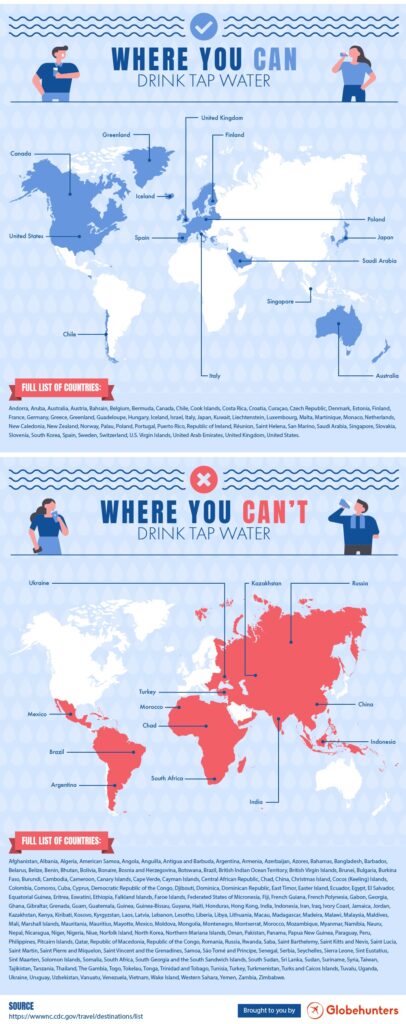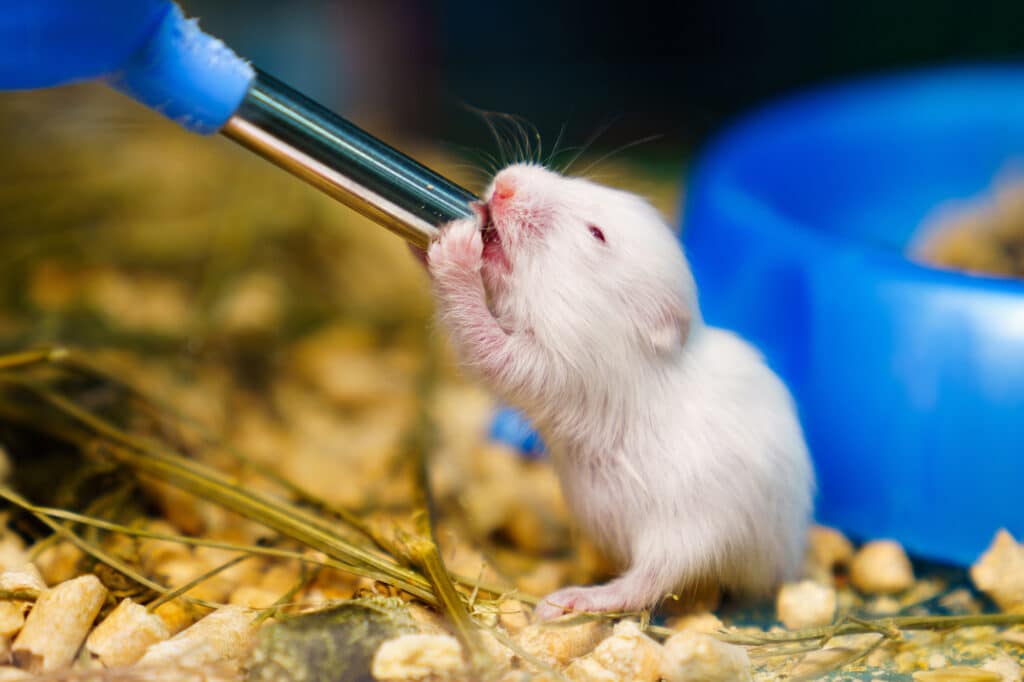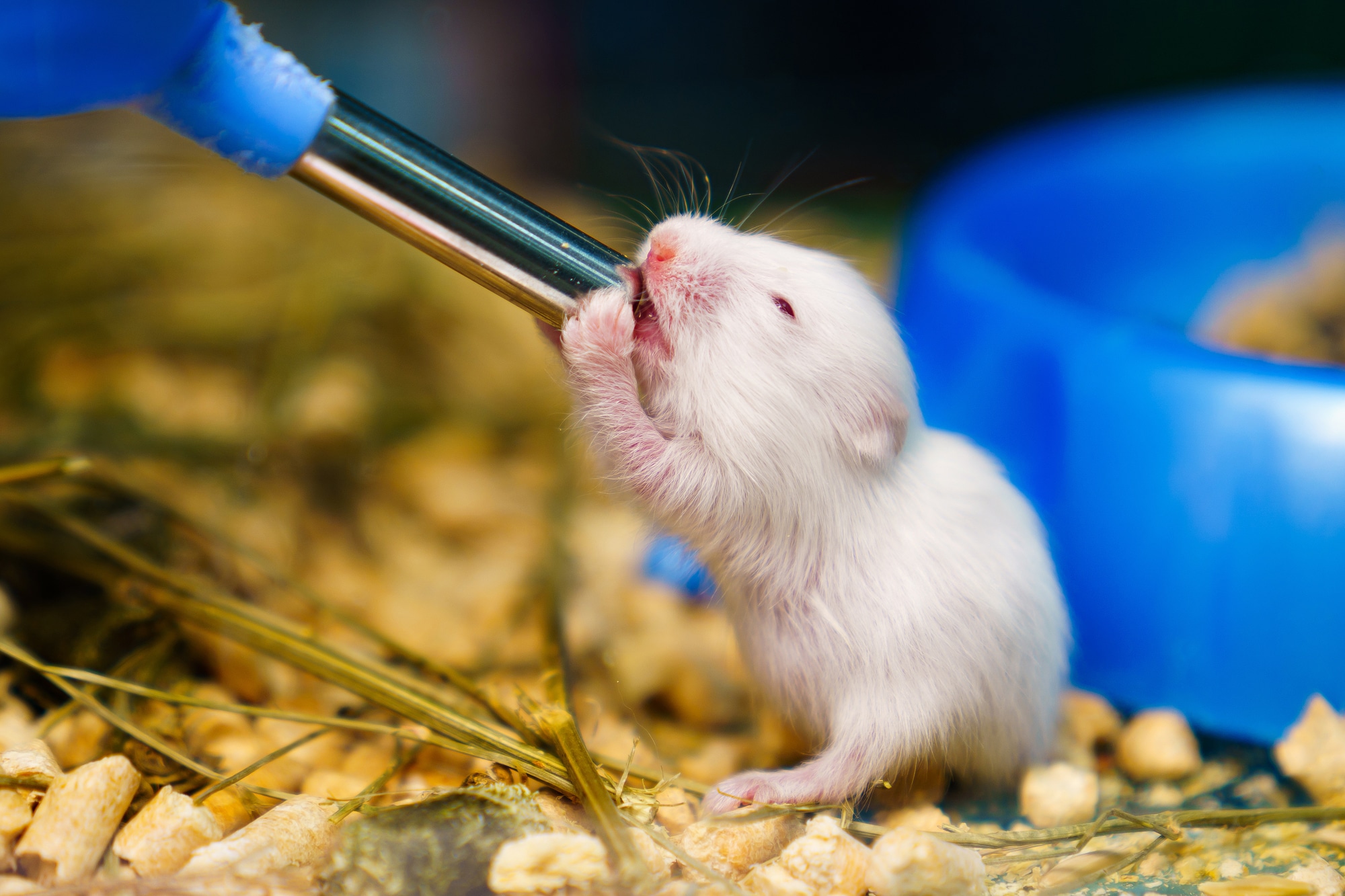Just like any other animal, hamsters need water to survive. Although just any type of water would help them survive, if you want your hamster to lead a long, healthy, and happy life, giving him the right type of water is of utmost importance. So, in this blog post, we will look at the cheapest and most easily available source of water, Tap water, and answer the pressing question that is on your mind right now – Can hamsters drink tap water? If not, how to make it safe for your hamster to drink? Keep reading to find out.
Before we dive in and determine if our hamsters can drink tap water, let’s first look at what tap water is and when and where it is safe to drink.
- Tap water
- Purifying tap water
- Bottled water
- Verdict – Which water should hamsters drink?
Tap water
We all know what tap water is. So, no explanations are needed there. But do you know where it comes from?
Where does tap water come from?
Tap water typically comes from a surface water source or a groundwater source. Surface water is the water from streams, rivers, lakes, reservoirs, etc. Groundwater is the water that collects in spaces between rocks under the ground and in underground aquifers. To get groundwater, we drill holes into the ground and pump the water to the surface. Depending on where you live in the world, the proportion of water you get from these sources will vary.
Tap water is normally provided by your local water utility company. But groundwater can also be obtained from an individual water system like a private well.
What are the risks of drinking tap water?
The health risks associated with drinking tap water arise due to the fact that it is not 100% water. It can contain contaminants that can cause gastrointestinal problems, neurological disorders, and reproductive issues, thereby damaging your health in the long run.
What are contaminants?
The Safe Drinking Water Act defines “contaminant” as any physical, chemical, biological, or radiological substance or matter in water (Source: The United States Environmental Protection Agency). Hence, everything (present in water) that is not a water molecule can be considered a “contaminant.”
Contaminants can be classified into four types:
Bacteria and parasites
When sewage and wastewater are discharged into freshwater sources, they can introduce harmful pathogens and parasites like E. coli, Cryptosporidium, and Giardia. If the water from these sources is not treated properly, these pathogens can reach your home through water pipes. Drinking tap water contaminated with these pathogens can make you and your hamster sick.
Water contaminated with bacteria and parasites can cause a myriad of illnesses, including mild problems like gastrointestinal issues (symptoms include diarrhea, headache, fever, etc. ) and life-threatening diseases like hepatitis, cholera, and typhoid.
If harmful microorganisms are detected in drinking water, the local health authority (at least in developed countries like the USA) will assess the risk and may declare a “Boil water advisory.” (Source: Healthline)
Chemicals
Chemicals, both natural and artificial, can be present in tap water. Pesticides, bacterial toxins, and bleach may bleach into tap water.
Nitrates used in fertilizers can reach rivers or groundwater sources and contaminate drinking water.
Chemicals like medical drugs and bisphenol-A (a chemical used to manufacture plastics) can also contaminate groundwater sources. They can find their way into tap water if you pump water using a private well.
Exposure to high doses of such chemicals can cause non-severe problems like skin discoloration and severe problems like damage to internal organs and the nervous system, developmental and reproductive difficulties. Exposure to low doses of such chemicals over an extended period can cause chronic diseases like cancer.
Heavy metals
Harmful heavy metals like arsenic, lead, and mercury can reach groundwater sources through natural underground mineral deposits and can reach surface water sources due to pollution. Lead can also get into tap water through old lead pipes.
If consumed in excess, heavy metals can cause liver, kidney, and intestinal damage, anemia, and cancer.
Radioactive elements
Even though rare, radioactive elements like uranium, plutonium, and cesium can also be detected in water. Drinking water contaminated with these chemicals can expose you to harmful radiation that can damage your body cells and cause cancer.
Until now, we looked at the health risks associated with drinking tap water. But does it mean tap water is dangerous for your health? Does it mean that you should never drink tap water at all? Or is tap water actually safe for you and your hamster to drink? Keep reading to find out.
Is tap water safe to drink?
In many developed countries like the USA, Canada, Germany, etc., tap water is actually very safe to drink. In such countries, government regulatory authorities regularly check the quality of tap water to ensure that the amounts of different contaminants are within permissible levels.
For example, in the USA, the Environmental Protection Agency regulates drinking water standards and ensures tap water is safe to drink (Find out how on this website). In Germany, The Drinking Water Ordinance issued by the Federal Ministry of Health regulates and checks the quality of drinking water (Source: German Federal Ministry for the Environment, Nature Conservation, Nuclear Safety, and Consumer Protection).
Don’t know if the tap water in your country is safe for you to drink? The Infographics below can help:

Can hamsters drink tap water? What should you watch out for?
Even if you live in a country where tap water is safe for humans to drink, it still might not be safe for your hamster to drink it due to the following reasons:
1. Chlorine content in tap water
In many countries (including the USA), chlorine is used to treat water because it is a good disinfectant. Chlorine kills bacteria and other harmful microorganisms and continues keeping the water safe until it reaches your home. However, chlorine has side effects too.
According to a study conducted on 2,211 people in the USA, an increased amount of dichlorophenols (used in pesticides and also for chlorination of water) led to an increase in food allergies (Source: Annals of Allergy, Asthma, and Immunology).
Trihalomethanes are chemical compounds formed when chlorine reacts with the organic matter in water. Drinking tap water can expose you and your hamster to these compounds (Source: Government website of the province of Nova Scotia, Canada). According to a study conducted on 396,000 people in Taiwan in 2008, exposure to trihalomethanes during pregnancy can increase the risk of birth defects in babies (Source: Environmental Health Journal).
According to a scientific paper published by the Department of Family and Community Medicine at the Medical College of Wisconsin, USA, in 1995, the by-products of chlorination of water could increase the risk of rectal and bladder cancer, probably contributing to 8,000 cases of rectal cancer and 5,000 cases of bladder cancer per year in the USA (Source: PubMed). However, subsequent studies on the same subject couldn’t find any significant connection between chlorine and rectal and bladder cancers (Source: Long’s Ecowater Systems).
However, many countries have regulations in place to limit the amount of chlorine and by-products of water chlorination in tap water so that it is safe for human consumption. So, the amount of chlorine in your tap water is normally too little to be hazardous to you. However, considering how little hamsters are, this amount could still be very harmful to them.
2. Hardness/Softness of water
The hardness of water is determined by the amount of calcium, magnesium, and other mineral compounds dissolved in it. Based on the amount of calcium carbonate dissolved in water, water can be classified as:
0 to 60 mg/L – soft
61 to 120 mg/L – moderately hard
121 to 180 mg/L – hard
181 mg/L and above – very hard
As water moves through rocks and other solids, it dissolves small amounts of minerals and brings them to underground water sources. So, if your tap water comes from a privately owned well, there is a chance that it could be hard. The map below depicts the hardness of the water in the underground water sources in the USA based on a study of over 2,100 domestic wells in the country.

But even though hard water can be detrimental to fabric, pipes, and industries, it is not dangerous for humans. On the contrary, even extremely hard water is found to be beneficial for humans since it compensates for the lack of calcium and magnesium in the diet. Even if we consume excessive amounts of calcium, our intestines can absorb them with the help of Vitamin D. But too much calcium can affect the absorption of other minerals like iron, magnesium, manganese, and phosphorus (Source: PubMed).
Hard water may not be dangerous for humans, but for small animals like hamsters, hard water can lead to bladder stones.
While hard water contains a higher concentration of calcium and magnesium, soft water contains a lower concentration of these minerals but a higher concentration of sodium. Soft water is not dangerous for healthy people. But it can be detrimental to those with high blood pressure, cardiovascular diseases, and kidney problems (and to hamsters, too).
So, can you give your hamster tap water?
As to the question of if you can give your hamster tap water, the answer is probably no. Even if you live in a country where tap water is safe to drink, and the tap water you get is soft and doesn’t contain much chlorine, you shouldn’t give your hamster tap water directly.
It would be wise to first get your water tested for contaminants. Moreover, even though soft water is better for hamsters due to its low mineral concentration, it is a good idea to consult a veterinary doctor beforehand. If your hamster has preexisting conditions that require you to limit the sodium in his diet, soft water should be avoided.
What can you do to make sure that the tap water is safe to drink?
If you live in a country where tap water is safe to drink and meets the criteria mentioned above, you can drink it. But before you give it to your hamster, there are some steps you must follow (more on this later). But let’s first see what to do if the safe tap water suddenly becomes unsafe to drink.
If harmful microorganisms are detected in tap water, the relevant government organization will issue a “Boil water advisory.”
What to do during a “Boil water advisory”?
During a “Boil water advisory,” it is advisable to use bottled water. However, if you don’t have access to bottled water, you can also boil the water (bring water to a rolling boil) and let it cool before drinking it.
If you draw water from a private well, then the owner of the well is responsible for making sure that the tap water is safe for drinking.
Until now, we looked at why hamsters shouldn’t drink tap water. Now let’s find out how to treat tap water so that your hamster can drink it.
Purifying tap water
Filtering
There are different types of water filters available. Depending on which contaminant is predominant in your water, you can use any one or a combination of the below filters:
1. Mechanical filters
In this type of filter, dust, sediment, or foreign particles are removed from water by making water pass through an ultra-fine barrier. Mechanical filters are often given a micron rating. Mechanical filters with the lowest micron rating of 0.5 (1 micron is one-millionth of a metre) can remove even harmful pathogens from water. But they cannot remove dissolved chemicals or extremely fine particles.
2. Activated alumina filters
These filters are good at removing fluoride, arsenic, and selenium from water. The molecules of these chemicals chemically bond with Alumina (Al2O3) molecules due to adsorption (The process where foreign particles bond with the topmost layer of a material, just like a magnet attracting iron particles). So, there is no risk of these toxins leaking back into the water.
3. Carbon filters
Like Activated alumina filters, Carbon filters also work on the principle of adsorption. Carbon filters can remove pesticides, herbicides, chlorine, and the bad taste and odor that comes due to the chlorination of water. However, they cannot remove minerals, salts, dissolved inorganic substances like iron, lead, manganese, fluorides, and pathogens like bacteria and viruses (Source: Wikipedia).
Like Mechanical filters, Carbon filters also come with a micron rating that indicates the size of the particles they can remove. Moreover, the speed of the water flow also affects the efficiency of a carbon filter – The longer the water takes to move through the filter, the more impurities that are filtered.
4. Ultraviolet filters
As the name indicates, in these filters, ultraviolet radiation is used to kill pathogens in water. Ultraviolet filters are very effective in removing bacteria and effective in removing viruses. But they cannot remove the chemical contaminants in water.
Ultraviolet filters can be costly. But you can create a temporary ultraviolet filter at home by filling a transparent plastic bottle with water, shaking it for water and oxygen to mix, and leaving it in bright sunlight for 6 hours at the least. The resulting ultraviolet radiation and heat from the sun will kill most of the harmful microorganisms in the water.
One thing you have to remember, though, is that ultraviolet radiation cannot pass through inorganic matter. So, ultraviolet filters are most efficient when used at the end of the filtration process when all chemical contaminants have already been removed from the water.
5. Water Ionizers
The tap water we get is mostly neutral. In some places, it can also be acidic. Acidic water, however, can leach metals like lead, manganese, copper, and iron when they move through pipes (Source: UCLA Health). When you or your hamster drink water contaminated with these metals, it can lead to diarrhea, suppression of the immune system, etc., and cause damage to internal organs. Acidic water can also damage the teeth and bones (Source: Healthline).
On the other hand, drinking alkaline water is considered safe (Source: Healthline). Several people claim that alkaline water can neutralize the acid in the bloodstream, thereby preventing heart diseases and reducing the risk of chronic diseases like cancer (Source: Mayo Clinic). However, there isn’t any substantial research to back these claims (Source: Washington Post).
Unlike the other filters we saw above, Water ionizers don’t purify water that much. But by making use of the electrically charged minerals in the water, Water ionizers split water into alkaline water and acidic water and also soften it. You can use the alkaline water for drinking. However, since Water ionizers are not good at filtering water, it is indispensable to use a water filter before sending the water to a Water ionizer.
6. Reverse Osmosis filters
In these filters, water is forced through a semipermeable membrane (with a pore size of approximately 0.0001 micron) at high pressure. As a result, most of the contaminants, including parasites, chlorine, fluorides, heavy metals like arsenic and lead, and common metals like calcium and magnesium, are removed.
Reverse osmosis filters are highly effective filters (Source: Forbes). However, they are expensive.
So, which filter should you go for?
There is no one correct answer to this question. But to figure out which filter you must use, you should first test your tap water. Then, depending on which contaminants it contains, you should choose a filter that is good at removing these contaminants.
But in general, the most effective way to filter water is to use a Reverse Osmosis filter in combination with another filter like a carbon filter.
Distilling
In this process, water is heated to the boiling point. Then, the water vapor is collected and allowed to condense while leaving the contaminants behind. This is a very effective way of purifying water. Most of the contaminants, including parasites, organic chemicals, arsenic, lead, chromium, nitrates, sulfate, and sodium, are removed (Source: Centers for Disease Control and Prevention).
Bottled water
If you think that bottled water is a really pure source of drinking water, you may be wrong. In the USA, for example, the FDA (The Food and Drug Administration) treats bottled water as food. So, it requires that the source of the bottled water be identified (river, spring, etc.), regulates the permissible levels of physical, chemical, radioactive, and microbial contaminants, requires that GMP (Good Manufacturing Practices) be used, and regulates labeling.
But FDA doesn’t have a mandatory testing program for bottled water like the EPA has for tap water. So, there isn’t any assurance that the bottle of water you purchased is safe (Source: WebMD). It can only be recalled once a contamination has been found.
So, even if you feel that bottled water is 100% safe, it may not be the case.
Verdict – Which water should hamsters drink?
You should give your hamster clean water that doesn’t contain any physical, chemical, or biological contaminants and is sufficiently soft. But which type of water satisfies these requirements? Let’s find out.
Can hamsters drink tap water?
As explained above, raw water (raw tap water) can contain too many contaminants. Even though the amounts in which these contaminants are present are not dangerous for humans, they can be dangerous for hamsters. So, it is better to filter the tap water before giving it to your hamster.
Can hamsters drink filtered water?
Filtered water is one of the best water for hamsters. But you have to ensure that the water is filtered to adequately remove the contaminants, i.e., you have to choose a suitable filter based on the contaminants that are prevalent in your tap water.
For example, if only biological contaminants are found in your tap water, you can create a temporary ultraviolet filter, as explained in a previous section of this blog post. If your tap water contains a lot of chlorine and smells and tastes bad, you can go for a carbon filter.
In general, however, by using a Reverse Osmosis filter in combination with another filter like a carbon filter, you can get water that is 99.9% pure (Source: Aquacure Water Purity Experts). Another very effective way of purifying water is to distill it. You can give your hamsters distilled water or water that has been properly purified.
Can hamsters drink bottled water?
Not all bottled water is the same. Moreover, they are not tested by a government organization; they are only tested by the water bottle company. So, make sure you purchase water bottles only from trusted manufacturers. Read the label to find out where the water comes from and how it has been treated. When in doubt, call the company that bottled the water to learn more about the water and find out if it is safe for your hamster to drink.
You can also consult a veterinary doctor to find out which water is safe for your hamster to drink in your area.
Now that you know which water is best for hamsters, find out how you can offer water to your hamster. Read my next blog post here: Can hamsters drink out of a bowl?



